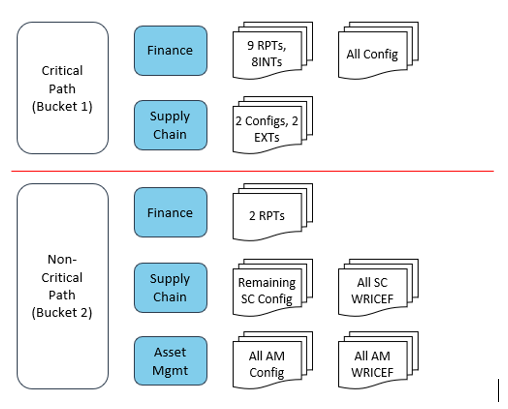- Ryan McGhee
- Reading Time: 5 minutes

Introduction
If your design phase is one month behind, but your build phase is scheduled to start next week, do you pause the whole program or press ahead despite incomplete designs? This common dilemma facing IT leaders isn’t merely about timelines—it’s fundamentally about managing risk. The question is: How do we effectively balance cost, scope, schedule, and quality today to protect our goals tomorrow? The answer often lies in phase containment in IT projects.
Entry/Exit Criteria: Managing Phase Transitions
Entry Criteria: Conditions required to start a phase.
Exit Criteria: Conditions required to close out a phase, typically tied to a payment milestone.
Having clear entry and exit criteria is helpful to limit risk while holding the SI accountable for timely, on budget delivery. Waterfall methodologies typically state holistic phase criteria (e.g. “100% design completion and sign-off”), while Agile methodologies handle this incrementally.
Regardless of methodology, it is common to fall short of 100% completion of all interim milestones when you’re supposed to transition into the next phase. There are likely financial penalties such as holdback or forfeiture to be addressed, but from an overall project perspective it must be asked, “At what point does the risk of incomplete milestones outweigh delaying your next phase?”
Plan for Phase Overlap from the Start
True Waterfall approaches with strict sequential phases are increasingly rare. Similarly, Agile methods advocate overlap and iteration, though uncontrolled overlap can introduce additional risks. Instead of reactively scrambling when 100% of the designs are incomplete, proactively plan for controlled overlap from day one to better manage and mitigate associated risks.
How to Maximize Phase Overlap while Minimizing Risk
1. Define your Critical Path
Identify the deliverables that are essential for a successful go-live. Clearly distinguishing between what must be delivered and what can reasonably shift ensures focused execution. Remember, if everything is critical, nothing truly is.
2. Align Deliverables to Milestones
Once the critical path is clear, group deliverables together logically by asking:
- What must be finished before the next phase?
- What can be iteratively refined without major disruptions?
- What is low-risk relative to other modules/deliverables/etc.?
- What deliverables operate independently?
These questions can help you determine the number of deliverables to track within a given milestone. Once you’ve done that, develop a comprehensive list of dependencies, at least for the critical path items.
For example, your project might include Finance, Supply Chain, and Asset Management, but perhaps only Finance is truly critical. Within Finance, determine precisely which components or reports are absolutely necessary for initial delivery versus those that can follow.
It might look something like this:

Finally, determine if this level of tracking is feasible for your organization, pivoting if necessary. For example, with a mature PMO, tracking at a deliverable level including dependencies shouldn’t be an issue.
If the PMO lacks discipline or has not had time to mature as an organization, it will be less risky to track at a higher level (e.g. modules). Metrics that cannot be reliably produced or managed may look nice, but they lie.
The purpose of this thought exercise is to define how you will track delivery, which will determine at what level you write your entry/exit criteria.
3. Align Entry/Exit Criteria with Milestones
Entry/exit criteria should reflect the logical groupings you’ve created. Ensure criteria are clearly defined at the milestone level:
- Are critical path milestones genuinely independent of non-critical path milestones?
- What constitutes completion for each milestone?
- What criteria allow each milestone to move forward into the next phase?
- Are all deliverables in the SOW mapped to a single set of entry/exit criteria?
If the entry/exit criteria isn’t contractualized within the Statement of Work, it may as well not exist.
4. Organize Project Plans and Reporting
Effective project management requires organizing plans and metrics around clearly defined milestones and your identified critical path. Prioritize tracking by deliverables by milestones within your plans through:
- Clearly summarizing critical path status using concise visuals (“Project on a Page”).
- Aligning all metrics directly to your defined milestones.
- Synchronizing your reporting cadence with key project milestones to maintain accountability and transparency.
Dashboards should be clear and straightforward, designed for quick interpretation by busy executives, not overloaded with unnecessary detail. If leadership can’t assess critical path status within 20 seconds, the presentation needs simplification.
Tailor your reporting based on your audience:
- Managers: Produce a concise, accurate one-page summary (“Project on a Page”) with detailed supporting slides as needed.
- VPs and Senior Leaders: Ensure teams understand exactly which metrics you require for decision-making. Coach them to consistently provide clear, accurate, and actionable data aligned to your strategic objectives.
Effective reporting isn’t about presenting extensive data – it’s about providing the right information at the right level at the right time to enable informed decisions.
5. Proactively Adjust as Necessary
No plan survives first contact with reality. You need to monitor and adjust proactively by:
- Looking at lead measures rather than lag measures to detect issues quickly
- Establish interim mile markers to validate progress frequently
- Prioritize completing critical path deliverables by milestone instead of tracking overall percent complete to minimize disruption
Entering testing with 100% critical path completion and other work at 70% is likely less risky than having 80% completion across all areas.
Mid-Flight Course Corrections
Lack of Upfront Planning
Even if disciplined upfront planning didn’t happen, there’s still hope to get the project back on track mid-flight—though it requires a focused, rapid response. In order to get back on track, you must:
- Validate contractual milestones and associated deliverables
- Audit deliverables to distinguish completed items from those still outstanding
- Identify critical path deliverables and map out all dependencies
- Clearly determine and communicate which items can safely proceed and which must remain on hold until dependencies are resolved
For example, if 10 deliverables have completed their build, but 4 rely on unfinished components, begin testing only the 6 independent items.
Clear Lines of Communication
Communicate explicitly why certain deliverables are moving ahead while others wait, ensuring alignment across teams. In addition, ensure:
- Clear and timely communication regarding decisions has been disseminated to all teams who have a need to know
- There is a clear plan in place to communicate any further changes to the teams
- There is a clear plan in place for the teams to escalate further changes that may impact downstream or upstream deliverables
The Bottom Line
Phase containment doesn’t require rigidity; it requires discipline. By planning with clarity from the start or quickly adjusting in mid-flight, leaders can minimize risks, manage expectations realistically, and achieve outcomes aligned with strategic goals. Effective phase containment balances structure with flexibility, ensuring projects meet critical objectives without adhering to seemingly arbitrary ridged rules or falling victim to chaos.
If your current system integrator relationship isn’t delivering—or you’re unsure how to reset and realign—don’t miss our upcoming webinar: “Evaluating Your SI Relationship: It’s Time to Reset and Be Bold”. Join our executives as they share actionable strategies to assess, recalibrate, and take bold steps toward a more effective SI partnership.
Related Blogs
M&A in 2025: Prey or Potential for IT?
Turning Gen AI Promises Into Measurable Value in ERP Programs
Midstream, Not Mid-Failure: Reclaiming Control and Value in Your ERP Program
About the Author
